► CAR lives with a used Tesla
► Model S long-term test review
► The long-term test verdict
Have we become fully signed-up members of the Teslarati after living with a Model S all year? It’s certainly one of the most fascinating long-term tests we’ve conducted recently and one that required a substantial mindset shift; like a theatre goer’s willing suspension of disbelief, you may need to park your prejudices before you join the Tesla cult.
Our 85D was an approved-used model first registered in 2016. It arrived with 16k miles on the odo and was for sale at £57,200. That steep price is one of the few immutable obstacles to ownership, although a Tesla dealer would finance our car for a still-punchy £770 a month. But would you really choose this over a new Jaguar i-Pace at £65k list?
Nothing failed or broke during our test and we returned the car to Tesla UK with no problems or glitches to fix. Occasionally we had to reboot the central screen when it froze; you can see why people talk about Teslas as being smartphones on wheels. This is a common glitch, owners report.
The best electric cars you can buy
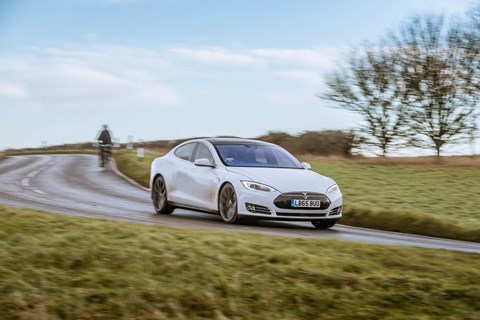
Nearly all the car’s functions are controlled from that huge 17-inch touchscreen, dominating the dashboard. It invariably won admiring glances from new passengers and the user experience is close to faultless. If you can boss an iPhone, you’ll love this – the design is similar. The screen is so big, and the buttons and touchpoints so generously proportioned, that we never struggled to use it, even on the move.
The screen resolution is surprisingly low, however; you’ll find sharper and brighter in a Ford Fiesta nowadays. That’s a reminder that the Model S dates back five years, as is the way that the interior fit and finish are several rungs below that of a contemporary Audi, BMW or Merc executive saloon. It’s not badly built, but it lacks the quality of Germany’s best.
We can’t say the same of the drive. Our 85D had startling acceleration as standard and the dual motor’s all-wheel drive meant you could deploy it securely most of the time, although we often defaulted to Chill mode to extend battery range. It steered and cornered with surprising purity for one so generously shod on 21-inch alloy wheels, while its agility and fizzy performance belied its 2.2-tonne kerbweight.
The Model S is much better suited to a relaxed gait, however, with the quiet drivetrain soothing away long journeys, the roomy cabin a packaging marvel, built-in Spotify streaming your favourite music without gobbling any of your own data. Charging at one of Tesla’s Supercharger points didn’t cost us anything, either – this earlier car having free top-ups for life.
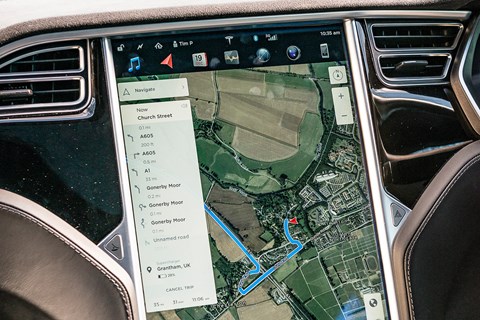
Running costs were remarkably modest, owing to the cheap cost of electricity. We consumed £294 of power over 5600 miles, the equivalent of just 5p a mile. That’s cracking value and the 85D’s 200-mile usable range meant we could easily take it on long trips to the other end of the country – so long as we factored in detour time for finding working charging points en route.
We had a few panics and learned to be patient; going electric in 2018 will cost you extra time (and coffee bills) if you use your EV as long-distance transport. This was less of a problem in day-to-day driving, when we survived on home charging and top-ups at the work Podpoint.
Suffice to say, our Model S nailed this EV malarkey. We just hope the company can overcome concerns over factories, finances and future product to transform from pioneering disruptor to electric car mainstream.
By Tim Pollard
Logbook: Tesla Model S 85D
Price £57,510 (approved used model)
Engine Twin e-motors, 518bhp, 485lb ft
Transmission Single-speed auto, all-wheel drive
Performance 5.2sec 0-62mph, 155mph, 0g/km CO2
Miles this month 626
Total 22,017
Energy consumption 392Wh/mile
Fuel this month £30.43
Extra costs None
Month 5 living with a Model S: tiny Tesla details
Look, no hands (sometimes)

Our 2016 Model S comes with the snappily titled Autopilot Hardware 1 with Convenience Features. It’s less advanced than the system on current Teslas, but still damn impressive: cameras read road markings ahead and keep you in lane and at a set distance from the car in front. Autonomous cars? They’re here today, folks – our Tesla’s system is the most advanced I’ve tried on public roads.
Watch your car drive itself

To engage Autopilot, simply double-tap the Merc-sourced cruise control stalk; if the lane markings are clear enough, they’re highlighted in blue on the dashboard and it’s hands-off time. The cute Model S avatar in the display is colour-matched and repeats your indicator and brake lights. Nudge the indicator and, if your blindspot’s clear, the car will pull into the next lane automatically.
Plenty to keep you busy: all the world’s music available through Spotify
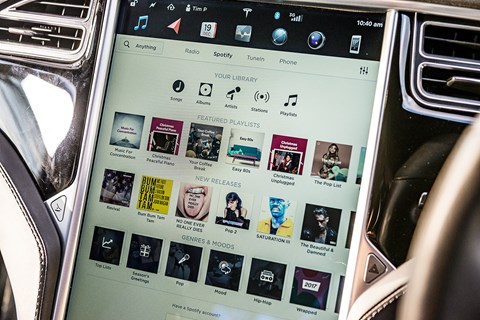
Okay, so you’re supposed to keep your hands on the wheel. But in reality, the Tesla’s Autopilot is one of the most relaxed we’ve tested. I never trust it enough to take my eyes off the road, but it’s a good safety blanket on longer trips – and lets you safely glance at the excellent Spotify music source. I love having all the world’s music at my fingertips.
By Tim Pollard
Logbook: Tesla Model S 85D
Price £57,510 (approved used model)
Engine Twin e-motors, 518bhp, 485lb ft
Transmission Single-speed auto, all-wheel drive
Performance 5.2sec 0-62mph, 155mph, 0g/km CO2
Miles this month 880
Total 21,391
Energy consumption 403Wh/mile
Fuel this month £43.62
Extra costs None
Month 4 of our Tesla Model S long-term test review: comparing with a Renault Zoe

Our colleagues over at car-buying bible Parkers.co.uk are running an electric car, under the watchful eye of CJ Hubbard, formerly of this parish. It seemed a good idea to swap notes.
The range on his Renault Zoe ZE40 Q90 is a realistic 100 miles, whereas we’re averaging nearly double that. I found the Renault’s artificial synthesised sci-fi whirr so loud it was annoying; it’s worth pointing out that our silent Tesla hasn’t yet mowed down any pedestrians. But the way the Zoe pours down the road silently, offers room aplenty and boasts a modest £18,920 price tag impresses.
It’s the democratic answer to our Model S, but does miss our car’s wow factor – stylistically, technologically and dynamically.
By Tim Pollard
Logbook: Tesla Model S 85D
Price £57,510 (approved used model)
Engine Twin e-motors, 518bhp, 485lb ft
Transmission Single-speed auto, all-wheel drive
Performance 5.2sec 0-62mph, 155mph, 0g/km CO2
Miles this month 767
Total 19,984
Energy consumption 420Wh/mile
Fuel this month £35.01
Extra costs None
Diary update: camping in a Tesla Model S with the DreamCase pop-up bed
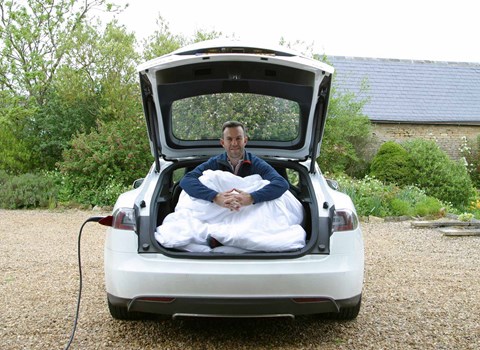
Well, we never thought we’d be doing this. There’s a new, unofficial accessory for your Tesla Model S that turns it into a mini camper van – and we’ve tested it. The DreamCase is available for the Model S, Model X and Model 3 Teslas (as well as other models, such as the Lexus RX) and the marketing spiel shows pictures of cool people taking their electric cars to cool locations, dappled in warm Californian sun. How could we resist?
It’s like a pop-out double bed in a box, that sits on a rubber mat in the boot of your Model S when unused. Although it’s not been approved for Ludicrous launches, the non-slip surface held the bed safe even under full acceleration in our 85D. Arrive at your campsite/layby/office in need of sleep, and you merely unzip the box and remove the contents:
- Fold-out double mattress
- Double duvet
- Two pillows
- Sheets and covers for bedding
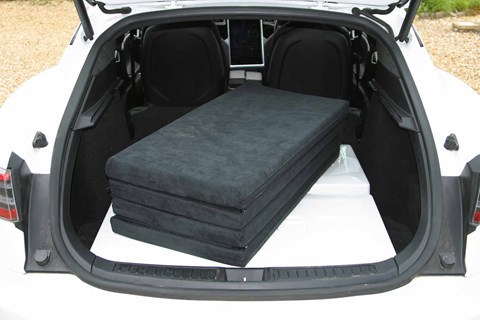
You can watch a video of the bed in action here. It’s remarkably easy to use and the mattress fits on top of the opened box; the Tesla’s regular boot is so big, this was the first time we’ve had to flop the rear seats forwards and we were impressed by how flat they fold, the geometry of the case making it a surprisingly even surface upon which to sleep.
There’s only so much you can cheat the laws of physics, however, and the Model S hatchback is an especially snug place to sleep for the night. This is no camper van and you’ll need to keep a window ajar to stop steaming up – or use the new Camper mode that keeps climate control working overnight (and is claimed to use no more than 30 miles of EV range for eight hours’ ventilation).
We liked the flexibility that a DreamCase camping bed brings to Tesla ownership. It’s well made, doesn’t take up the entire boot and means you can crash for a few hours’ kip, or even brave a night away for emergency sleepovers, with extraordinary ease. Its makers reckon that a fifth of car accidents are caused by drowsiness, so this might even prove a road safety boon (if the idea takes off).
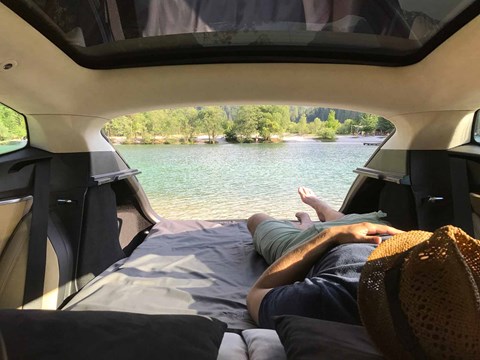
Was it comfy? I’ve camped on worse beds. An arm at one end of the mattress extends down to the floor, holding the head end of the mattress up; this was the only weakness in the bed I could spot – it creaks worryingly if you put weight on it. But if you lie flat on the DreamCase mattress, it’s perfectly comfortable for a camp bed.
Needless to say, my kids loved it more than my wife did. But the DreamCase lends an unusual new string to your Tesla’s bow. Get more info on this camping bed here.
By Tim Pollard
Month 4 living with a Tesla Model S 85D: the seven-seater option
The Model S is unique in the premium segment in offering seven seats – usually found on people carriers or SUVs, not purportedly luxury saloons. Of course, this exec has a hatchback, not a three-box boot, which is what makes the third row of seats just about viable. They’re a £2100 option, but were already fitted to our pre-owned car.
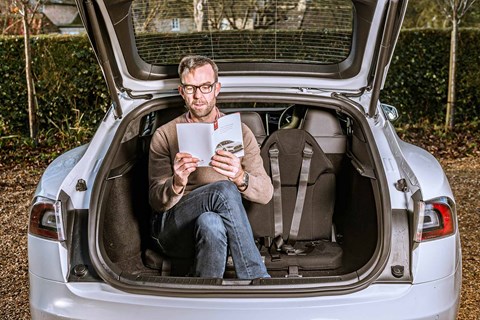
Clambering aboard in the name of science, using all my Twister-honed bodily contortion skills, confirms what I thought from the outset: these are titchy-tiny occasional seats for small children, and even then only for emergency use. They really ought to be covered by a sheet of protective glass and a small hammer.
It should come as no surprise that adults won’t easily fit in the back of the Tesla, but we’d question whether kids would be much more comfortable. I measured the shortest distance between seatback and hatchback at just 26cm – it’s claustrophobic and maybe not that safe (although it’s worth noting the Model S’s overall five-star Euro NCAP rating).
The reality of most third-row seats is that they are for occasional use only: squeezing in friends on a run back from the pub or playing school bus. It’s nice to know you have jump seats as back-up, but it speaks volumes that this family of four hasn’t ever used them.
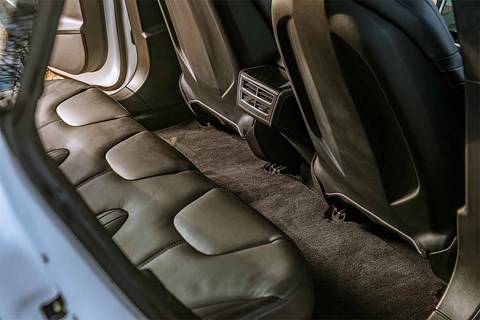
The seats are cleverly engineered and fold flat into the floor, leaving a large, uncluttered 894-litre boot. The powered tailgate lifts to reveal a sensibly shaped loadbay, which can expand to 1795 litres with the 60:40 split rear seats folded away. We tend to leave both charging cables and Chademo fast-charger adaptor sliding around and should really stow them in the Porsche 911-style ‘frunk’ up front, with an additional 150 litres.
It’s worth mentioning the cabin space for those not slumming it in the boot. The front two rows are roomy and the absence of a transmission tunnel means the floor is pleasingly flat (see above), with plenty of space for luggage, limbs and loafers. Our advice? Stay up front – don’t slum it in cattle class.
By Tim Pollard
Diary update: a Tesla virgin drives our Model S
Tesla fans are devout ones. Some of my friends (and plenty others besides) revere both the brand and everything Elon Musk has done, for better or worse.
I’m less of a fanboy; you can’t deny the things Musk has done in the past 10 years, but given Tesla’s recent financial and production hiccups in particular, I’m yet to be fully convinced by the Tesla mantra. So, when the key was free to Tim’s long-term Model S, I approached it with cautious curiosity rather than outright excitement ahead of my first time behind the wheel of one.
Read our guide to the best EVs you can buy
There’s always a sense of theatre with Tesla, even from the moment you walk up to it. The flush door handles swish out like someone holding out their hand eager to make your acquaintance. The humongous flatscreen TV bolted into the dashboard. Little details like the instrument display’s tiny version of the car showing the brake lights and indicators flashing in real time – and the picture of the vehicles in front and how it differentiates between lorries and cars in traffic ahead. It’s damn clever stuff.
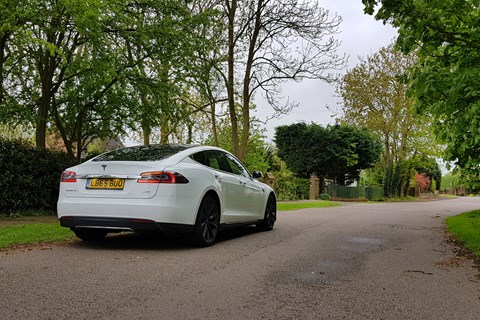
Then there’s the sense of speed, of course. Our used 85D model doesn’t have Ludicrous mode as it’s not a Performance-spec model, but the instant acceleration is properly addictive and was almost always enough to spark yelps of joyous surprise. Power is just always there for point-and-shoot slip-road blasts or overtakes. I appreciate that I’m explaining something that’s been explained a million times in terms of electric car power delivery, but it never, ever gets old. Until you check out how much range you’ve burned away – sorry, Tim.
Our five-metre long Model S is also not quite as big a barge to drive as you might think. There’s pleasing weight to the steering, the large-diameter, anodised turbine alloys don’t intrude too much into ride quality and chucking it into a corner gung-ho didn’t faze the air suspension.
Niggles? Well, few Tesla owners will notice but the Mercedes switchgear for the windows, gear selector, cruise and indicator were telling signs of cost-cutting and our car’s optional Premium Interior upgraded leather didn’t really feel all that premium. And while the lack of any centre console between the front seats only highlights the lack of need for any transmission tunnels, I struggled to find any use for the silicone-lined tray. I’d argue the space could be used to offer some more storage spaces to put your stuff.
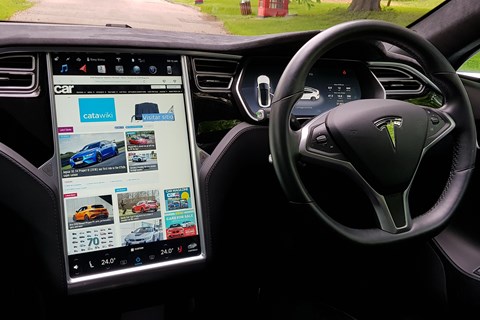
To drive, though, the Model S is a pretty swish executive car and a solid cruiser, and has plenty of little techy tidbits to keep the switched-on driver enthralled by the whole experience. Well, that along with the primitive thrill ride it gives you in a straight line. Whoooooosh.
By Jake Groves
Month 3 living with a Tesla Model S 85D: the Supercharger network
A few weeks of Tesla ownership under our belts, and the education process continues. We’ve met many other owners hovering around charging points and been struck how evangelical they are, eagerly sharing tips, apps and advice. Finding charging points en route is becoming second nature. And we’re now living the life electric – learning to minimise range anxiety with a little bit of advance planning and careful driving.

A recent over-the-air software upgrade introduced Chill mode, which is a slick rebranding of what BMW would call Eco Pro. It softens throttle responses and sets energy-draining services (heating and suchlike) to more energy-efficient settings. As it’s been a cold winter, we’ve welcomed the less savage acceleration and left the Model S to Chill out, while we’ve been learning about the car’s range.
Ours is a two-year-old approved-used 85D, remember, and all the indications are that the claimed battery performance is where it should be. Tesla quotes a 270-mile range for our battery spec and even in the clutches of the deep freeze that has never dropped below 250 miles. It’s more typically showing an indicated 260-265 miles when fully charged, and we hope that may climb further as the year warms up.
Does it actually drive 250+ miles on a single charge, though? No, it does not. This is disappointing on some levels (surely it’s not beyond the wit of Silicon Valley to design an algorithm to reflect real-world conditions, driving styles and temperatures?) and yet it’s a problem that afflicts all electric cars. And old-school combustion engines, come to think of it. When’s the last time a diesel exec really went 600-plus miles on a brimmed tank?
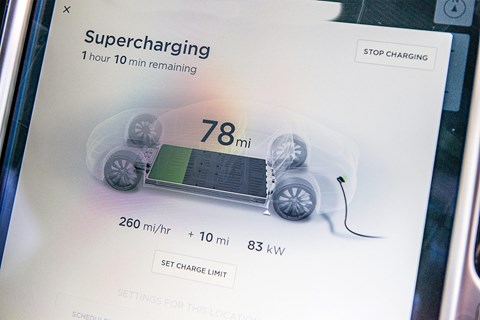
We’re lucky in that we have a fast Podpoint charger at the CAR offices, as well as two painfully slow three-point plugs. The former will return the Model S to full every day in around five hours, whereas a domestic socket is quite hopeless; so capacious is the Tesla’s battery that it will take a day and a half to top up by three-point plug.
This is where the Supercharger network comes in to play. Although nationwide, Tesla’s own high-speed charging infrastructure is concentrated around large conurbations and major transport corridors – meaning that our nearest one is in fact 30 miles away in Grantham. We’ve only been there twice as a result.
How to charge your electric car in the UK
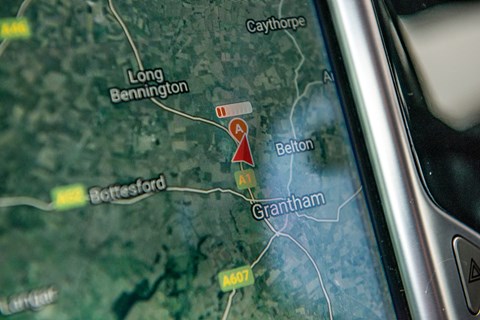
We have used Superchargers on the M40 regularly during forays to the south coast, and the ability to zap in 260 miles in less than an hour is a revelation. Even a 30-minute top-up while we have a coffee is enough to decimate range anxiety. We like the Tesla’s sat-nav feature confirming how many bays are in use, too (see above).
If only there were more Superchargers to make fast-charging a universal reality: they give a taste of how much more viable EV ownership is becoming.
By Tim Pollard
Logbook: Tesla Model S 85D
Price £57,510 (approved used model)
Engine 386kW twin e-motors, equivalent to 518bhp, 485lb ft
Transmission Single-speed auto, all-wheel drive
Performance 5.2sec 0-62mph, 155mph, 464kWh/mile, 0g/km CO2
Miles this month 1131
Total 17,548
Fuel this month £53.39
Extra costs None
Month 2 of our Tesla Model S long-term test review: driving the 100,000-mile Tesla Model S
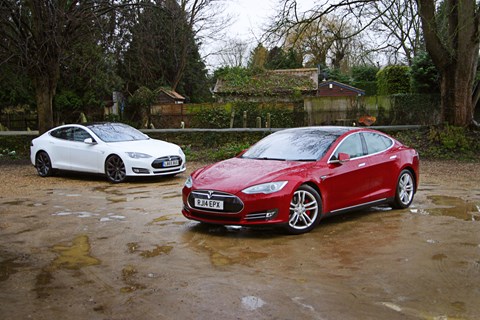
The first Tesla Model S electric cars landed on UK soil wearing 2013/13-reg plates, meaning that the earliest are now five years old and have had ample chance to rack up decent mileages. A quick look at the classifieds suggests the leggiest have done around 76,000 miles – a decent chunk for an electric car and a reminder of just how viable EVs are becoming, even for those commuting long distances.
Is buying a high-miles Tesla a good idea, though? We heard of one Model S that had just broken the 100k barrier – and managed to persuade its owners to let us have a go. The red car pictured above belongs to Chargemaster, the UK’s biggest provider of electric charging points to homes and businesses. The P85’s odometer had just ticked past 100,600 miles (see below) when it swung by our Peterborough HQ for us to compare notes.
Although we can’t be sure, we reckon it’s got a decent chance of being the highest-mileage Tesla in the UK. Let us know in the comments below if you know of a rival to that claim!

The P85 was bought new by the business’s founder and CEO, David Martell, and it has since transferred to the Chargemaster demo fleet of EVs, where members can win a Polar EV Experience week and sample one of the growing numbers of electric cars on sale today. We can only imagine it must get a hard and varied usage. But you wouldn’t think so when you first approach it.
The paintwork still has a decent lustre and the car is remarkably unblemished, give or take the odd scratch. We preferred the red paint and silver alloys of the Chargemaster car, compared with our solid white and grey Turbine rims, though that’s clearly a subjective choice. Conversely, our car’s black leather upholstery trumped the high-miler’s extremely cream interior, but both share a disappointingly cheap-feeling leather; ours has only driven 20,000 miles and the hide is already feeling quite shiny, low-rent and tired – and our visitor’s seats felt pretty worn too.
It’s a reminder that the interior of the Model S is feeling its age. Yes, the screen and operating system remain an ace card and still have wow factor to newcomers, but get up close and the resolution of the 17in display betrays its age; the screen in a humble Ford Fiesta supermini feels more HD. But everything worked in Chargemaster’s Tesla, despite having driven the equivalent of halfway to the moon.
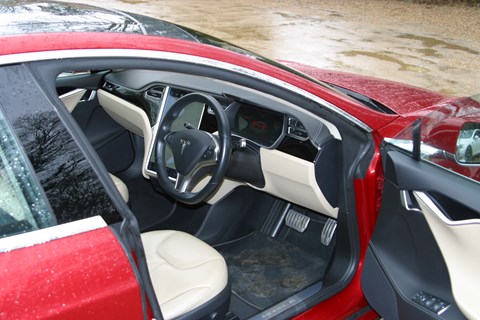
You’d be forgiven for worrying about the longevity of batteries over the long term, but driving this 100k Tesla was reassuring. All the major componentry was original and nothing in the drivetrain has been replaced. The only glitches in Chargemaster’s ownership have been:
- 2x electric pop-out door handles replaced under warranty
- A new Type 2 charging socket on the car replaced through wear and tear
- Digital screen replaced under warranty
Crucially, the electric powertrain has been faultless. Chargemaster reports that the 85kWh battery still holds its charge and the typical daily range on a full charge stands at 230 miles, down from around 240 when new – similar to how our 85D performs.
On the road, both cars ride remarkably well, considering their outsize rubber, and the red car steered, stopped and sprinted with impressive accuracy. Only a noticeable whine from the rear motor (theirs is the 2wd Model S P85, not all-wheel drive like our 85D) hinted at the stellar mileage it’s done.
All in all, it’s a great poster child for going electric. With fewer moving parts and less mechanical complication, it seems an EV can be a safe long-term bet, so long as you charge it appropriately and look after the battery. Chargemaster has a lot of experience of Teslas and reports they’re a sound long-term buy.
By Tim Pollard
Diary update: how the Tesla Model S is plugging into our life

We only charge our Tesla every few days in normal usage, unless we have an especially long journey in store. Three different charging cables came with our Model S:
- Three-point plug For charging at home via domestic supply (black lead)
- Type 2 cable For use at most electric charging points (blue cable)
- Chademo adaptor So you can use fast chargers (black adaptor in my right hand above)
That’s a slew of cable-ware to carry around with you – they take up a reasonable chunk of bootspace, we find. There is a recess in the left-hand side of the loadbay where the bulky Chademo adaptor lives, but the cables themselves tend to just slide around in the floor in a snake-like tangle.
Fortunately, the Tesla Model S boot is big at 894 litres, but we find the leads have brought quite a bit of mud into the loadspace during this long, grimy winter (see below).
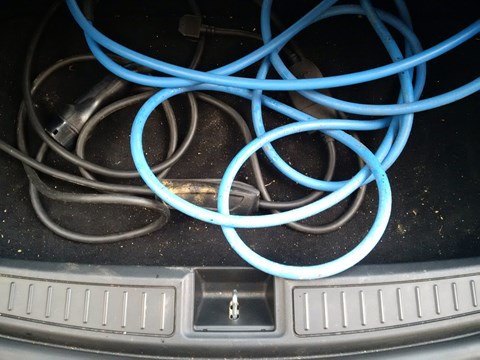
As a rule of thumb, we try to avoid using the black home charging three-point plug: our Model S 85D’s battery is so big, at 85kWh, that it takes around a day and a half to charge via a domestic plug. We mostly use the blue Type 2 cable – it is the most common EV charging plug and works on our Podpoint at work and the Chargemaster network, the UK’s largest chain of EV chargepoints.
What of the black Chademo adaptor? We haven’t actually used it yet. It’s designed for use at rapid chargers such as Ecotricity’s Electric Highway network at UK service stations, but since we tend to route via Tesla Superchargers on trunk roads and have a decent 200+ mile range anyway, we haven’t needed to use ours yet. It’s nice as a comfort blanket back-up though.
How to find your nearest electric car charging point
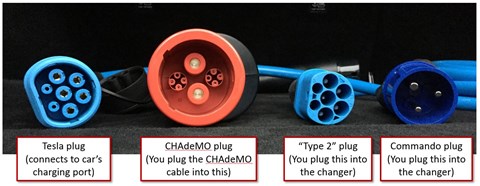
Having to navigate the complication of charging is one of the things that most deters potential customers – it’s fair to say we’re still some way off having a single universal plug protocol. It’s a bit like Apple vs USB vs third-party plugs for your domestic gadgetry (as neatly explained by Teslaownersgroup.uk above).
Next time we’ll discuss Supercharging in more detail (the own-brand, ultra-fast chargers you’ll see in some motorway service stations and elsewhere – they top up the battery in the time it takes to grab lunch). Our three-year-old used Tesla comes with free Tesla Supercharging for life – a big boon, and not something you’ll get on a brand new Tesla today or tomorrow. Play your cards right, and it can mean ‘free fuel’ for the foreseeable future.
By Tim Pollard
Diary update: what’s the Tesla Model S like to drive?
We’ve lived with our Tesla Model S 85D for a few weeks now and really got under the skin of the car. I first drove one back in 2014, when I boldly concluded: ‘The Model S changes everything.’ Four years later, as Europe inches towards catching up with California’s ground-breaker, is it still a stellar drive?
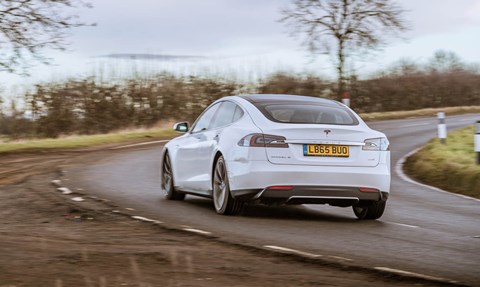
I’d argue on many levels, it is – but Tesla’s leadership is definitely being eroded by a tardy traditional car industry. Only last week at the 2018 Geneva motor show, we drove the new Jaguar i-Pace, for instance. Editor-in-chief Phil McNamara was impressed by the handling agility of Jag’s EV – as well as the sharp throttle response and roomy packaging. All epithets you could throw at the Model S, too.
Below we chronicle how the four-door behaves in the snow (admirably well, actually), but now that one of the harshest winters in recent memory is slowly withdrawing, we’re getting a chance to see how it performs in more clement weather.
How the Tesla Model S copes in winter snow
First impressions are still striking – the ogle factor is high when new recruits are introduced to our 85D. Keyless entry means the flush chromed door handles pop out seamlessly upon approach, key firmly in pocket (this four years before the Velar repeated the trick, remember!). Slide past the frameless doors, nestle into the rather flat leather chairs and you simply select D on the Merc-sourced column-mounted gearlever and drive off. No handbrake. No key. No buttons. It’s an impressively smooth and hassle-free departure lounge.
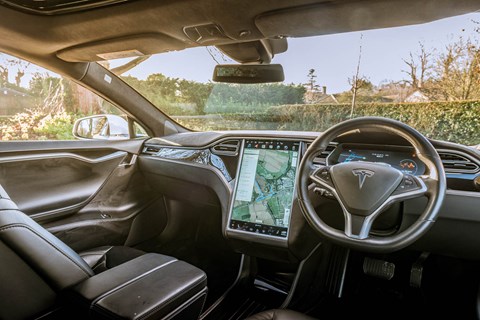
There’s the usual silent EV motion (obvs) and the controls are impressively light, lending a laidback, easy vibe to proceedings. I’ve been toying with the steering weight between Comfort, Normal and Sport (selected via the omnipresent giant touchscreen), adding increasing levels of power assistance. It’s perhaps at its best in the lightest setting, for fingertip control.
One of the abiding impressions is of a surprisingly comfortable ride, despite the giant 21-inch Continental 245/35 low-profile tyres upon which it rides (below). You’re always aware of the Model S’s weight (this is a 2+ tonne car, remember), but the heft of those batteries actually helps the ride smother road corrugations, I reckon.
Should you still buy a diesel car? We look at the future of derv
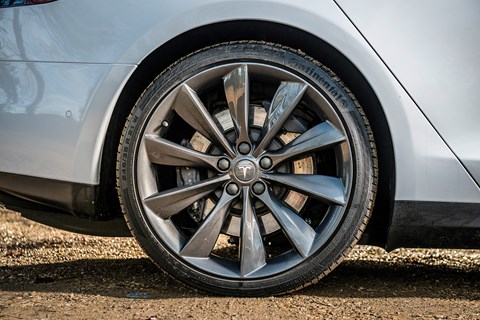
Up the pace and it’s no 5-series in the twisties, but you can hustle the Tesla Model S if you’re in a rush. The dual motor all-wheel drive really helps here and living in the rural Midlands I value the extra traction this affords. Slingshotting out of junctions is much easier and it never feels overwhelmed by the dizzy torque and power outputs, even on slippery roads. Only once have I seen the traction control light flicker this winter.
One beef I have noticed though, after a few days in another test car, is the compromised forward visibility. Those windscreen A-pillars are THICK, obscuring quite a lot of the road ahead and to the side when you come to T-junctions or roundabouts. And the rest of the interior? We’ll report back on that in a future update. With a minimalist interior and nearly everything controlled by that 17in touchscreen, there’s a lot to talk about…
By Tim Pollard
Browse used Teslas for sale
Diary udpate: how does the Tesla Model S perform in winter?
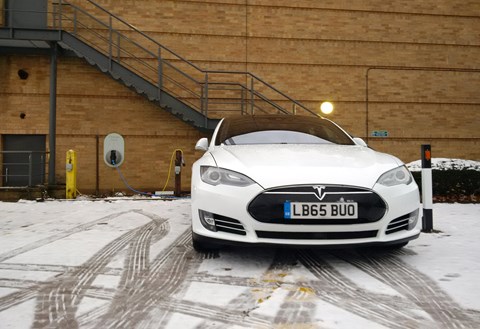
Electric cars aren’t supposed to be much fun in winter: they run out of range and all that electric grunt can prove treacherous in snowy conditions. And yet our new Tesla daily driver has been pressed into daily action throughout what has proved to be one of the coldest, iciest winters of recent years.
Bedecked, appropriately enough, in a solid white paint job, our 85D has the benefit of all-wheel drive from the dual motors and the added traction this delivers has been welcome. Ours is shod with summer Continental ContiSportContacts and despite the lack of winter tyres, it has felt surprisingly surefooted when driving in icy conditions, and even on compacted snow. I’ve been impressed: the traction control and ESP lights haven’t flickered on once, even on the slipperiest of conditions.
We had quite a skiddy moment last winter when CAR was running a (rear-wheel drive) electrified BMW i3 REX, but the chunky 21-inch, conventional rubber on our Tesla has provided more grip and reassurance, even when the mercury drops below zero.
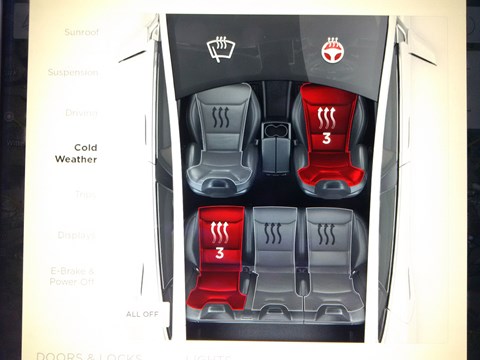
In other respects, our Tesla has proved decent winter transport, too. It’s quite a bonus having all five seats heated – the kids are enjoying the three-stage warmth adjustment on all three rear pews, and the steering wheel is toasty too. All are operated via the Cold Weather menu on the main touchscreen, using the control above (though the two front seats have a handy short-cut on the homescreen).
And as for range? We only picked our car up a few weeks ago, so we cannot yet compare summer with winter EV range. Suffice to say, we are able to squeeze just over an indicated 250 miles into our 85kWh battery on cold days; on the odd warmer afternoon, that might climb up to 265 miles.
Tesla claimed a 270-mile range when new, so it seems our battery is performing as intended after two years of use (ours is an approved used Tesla, remember).
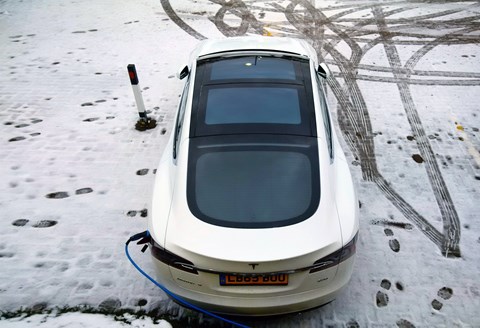
CAR has a Podpoint charging socket at work (wintry scene above) as well as some regular three-point plugs in the car park. The latter are risibly slow, taking over 24 hours to top up our Model S’s capacious battery, but the Podpoint is excellent, filling even a nearly-empty battery in around six hours.
We’ll be investigating the range and charging topics in more detail in the weeks ahead. Suffice to say, for now we’re seeing a realistic range of just under 200 miles on our 85D; this is mostly tested on longer journeys – which means juicy, high-speed motorway jaunts – and then we’re struggling to make 180 miles without recourse to a Supercharger or other plug en-route.
Bring on a warmer spring, so we can see just how far the Tesla Model S will go on a full charge in optimum conditions. For now, we’ve been impressed with just how well it’s shirked off the strains of winter.
By Tim Pollard
Month 1 of our long-term test review: it’s arrived! Time to collect our Tesla Model S
After the build-up, the research, the endless questions from mates and mums, the time has finally come. CAR magazine has collected our approved used Model S from Tesla’s UK headquarters and has become a fully signed-up member of the Tesla fraternity.
The HQ in west London doubles up as the London Heathrow dealership and we sat alongside a handful of owners popping in to collect their own purchases and service their electric vehicles. There’s a cool, calm, premium vibe percolating the showroom, which is sparsely furnished with minimalist furniture, Apple Macs and displays showcasing the various charging solutions available to private customers.
So far, so typical of any premium garage – but one distinguishing feature is the clientele. Tesla seemingly has a broad appeal, but there’s a strong interest from older, wiser, wealthier motorists, it seems. I guess the big-ticket prices make that inevitable, but perhaps it’s the spirit of early adoption and interest in high tech and ecology that binds Tesla customers together more. We’ll be talking to plenty of owners in the weeks ahead.
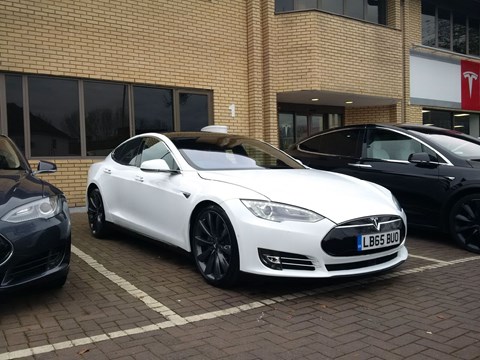
The handover was simple enough. Our car was plugged into a Supercharger to provide enough battery range to get back to CAR magazine’s Peterborough HQ 94 miles away, so we had a guided tour of the Model S 85D while we waited 20 minutes for sufficient charge to top up the batteries.
I’ve driven several Model S and Model X electric cars before, so it was more of a refresher guide to important functions and a whistle-stop tour through the huge touchscreen’s menus and tricks within.
Read our guide to the best electric cars and EVs on sale in the UK
Our car wears its mileage well: the bodywork and paint appear of good quality, although I’m not so sure of the wisdom of the polar white wardrobe of our test model; it’s going to be a pain to keep clean in these mucky winter months.
London-registered LB65 BUO came with a regular Type 2 cable and a three-point plug lead for emergency domestic recharging (warning: takes 24+ hours) – plus a CHAdeMO adaptor for connecting to the emerging fast-charge DC bays. Learning the lexicon of recharging is an inevitable part of EV ownership and we’ll be reporting on everything we learn on these pages.
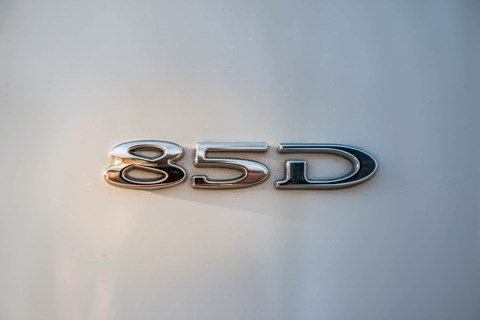
Battery topped up, we unplugged the cable, stowed it in the large boot and settled in to the wide leather seats. This is a large car at 4970mm long, but there’s a wide range of adjustment to the seats and mirrors, so the view out is decent in all directions (bar some surprisingly thick A-pillars you have to peer around at mini roundabouts).
Setting off in a Tesla Model S is something of an event. With keyless entry and ignition, you never need touch the key: simply approach the car, watch the door handles pop out (this car launched four years before the Range Rover Velar, remember), slide in, select Drive and disappear silently down the road. The lack of rigmarole and start-up procedure is an enduring joy.
Engaging D on the Merc-derived stalk gearlever, we crept out of the Tesla compound and headed on to the M25 and A1, heading north to Bauer Towers. It was a memorable journey for its very lack of drama – the 85D is rapid, silent and very stress-free to drive on an M-way journey.
We’ll save our driving impressions and more detailed observations for coming reports. Suffice to say, Tesla motoring is very different, even from other electric cars such as the Nissan Leaf or Renault Zoe. Stay tuned for much, much more.
You can soon read the full reports in CAR magazine, too, but we’ve started this Tesla long-term test review online earlier. We’re certainly not going to be light on talking points.
By Tim Pollard
Introduction: CAR is running a Tesla Model S long-term test review in 2018
Well, this is shaping up to be one of the most intriguing long-term tests we’ve ever conducted. We’re fortunate that our daily driver fleet has numbered McLaren supercars, Aston Martin coupes and a pukka Porsche 911 in its number, but never – until now – have we run a Tesla electric car.
That is being put right in 2018, as we’ve persuaded Tesla to lend us a Model S. The car you see here in our configurator spec will soon be appearing in the pages of CAR magazine with regular monthly updates and we’ll be reporting fully on the approved-used Tesla Model S 85D online too. Stay tuned for regular coverage as we reveal what it’s like to live with every day.

Why are we testing a Certified Pre-Owned Model S? Because Tesla was keen for us to try a secondhand model and as a fledgling player it doesn’t have airfields of unsold stock lying around. And besides, this is a great chance for us to test the reliability and quality of a two-year-old Tesla and to see if fears over battery degradation are unfounded or a real problem to used EV ownership.
Specifically, we’ll be looking to answer these questions:
- Is a secondhand Tesla a good idea?
- Do batteries degrade over time?
- Does a two-year-old Model S feel like new?
- Is an electric car a viable everyday proposition in 2018?
- How much does a Tesla Model S cost to run?
- Should you buy a used Tesla or are you better leasing one?
- Which Model S should you buy?
Ours is a 65-registered 85D in solid white paint, depicted in the stock list pictured here. You can read its spec in the photo below. We’ll soon be updating this page with real pictures, once the car lands on our test fleet and starts to be tested by the whole CAR magazine team day-in, day-out.
Should you spend nearly £60,000 on a secondhand electric Tesla? Do you run a Model S, or have you invested in a rival electric car? Do let us know your thoughts in the comments below!
By Tim Pollard
Read all our Tesla reviews here
